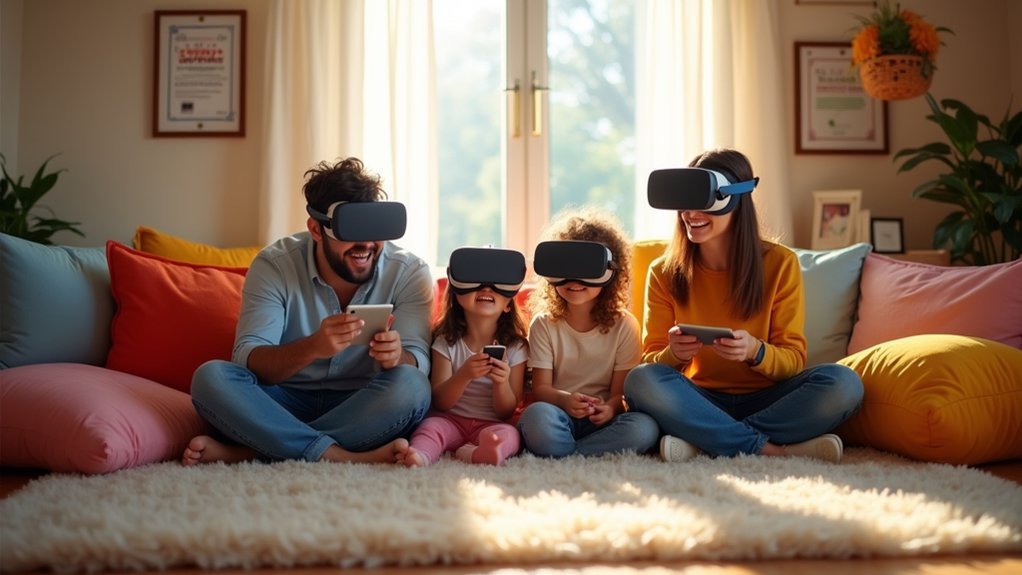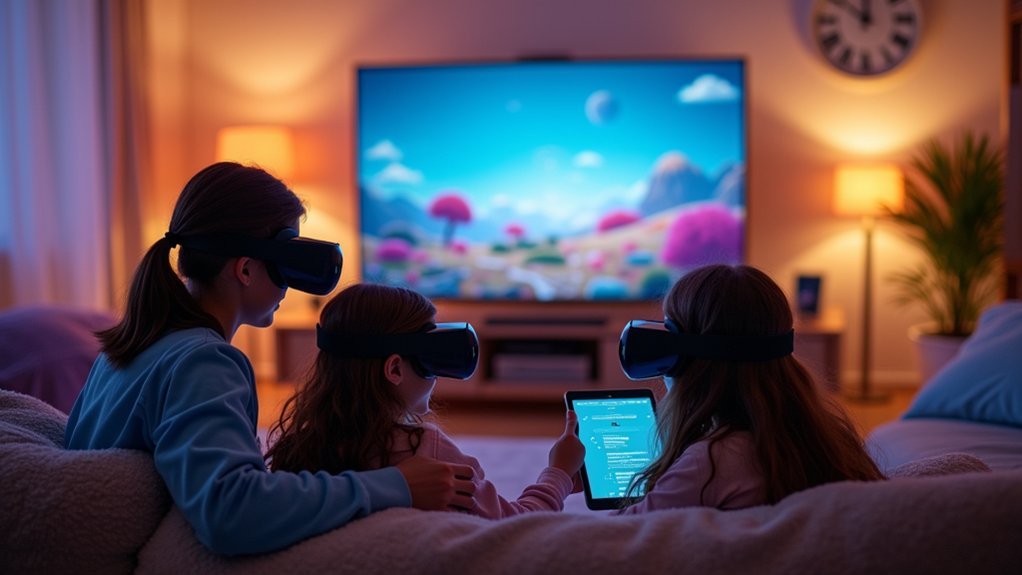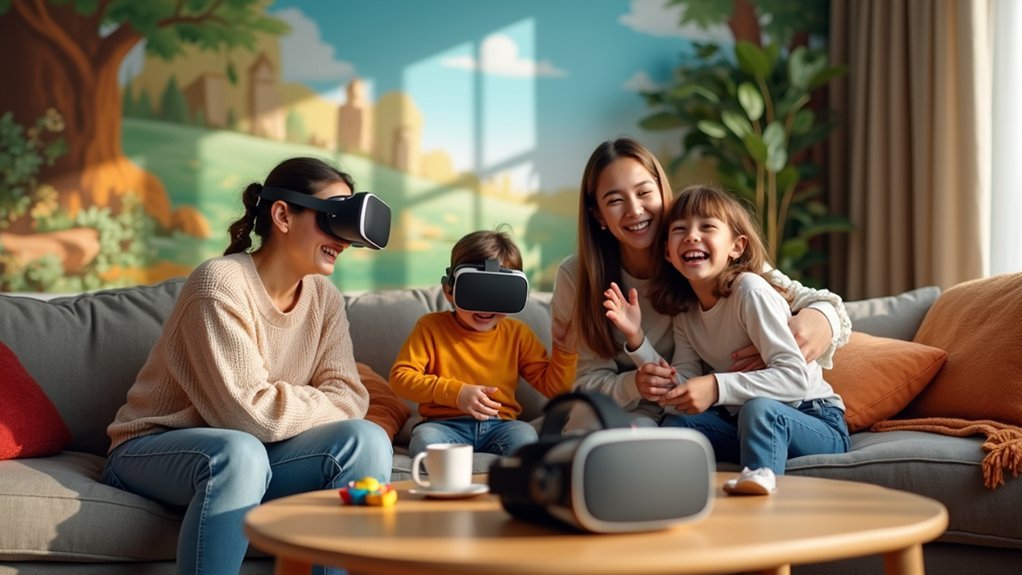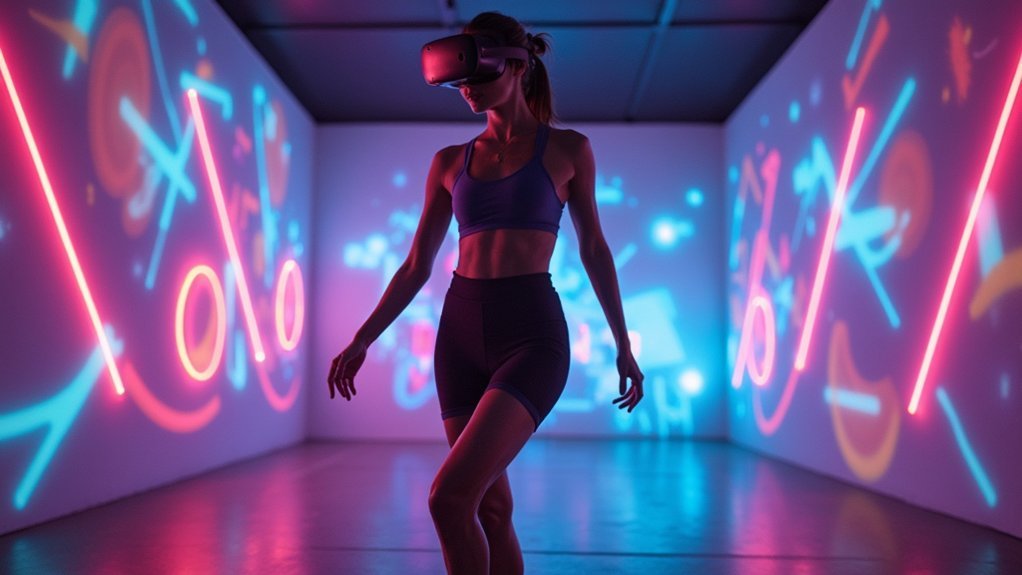You’ll need to establish both physical and digital boundaries to create safe family VR spaces. Set up a minimum 6.5 x 6.5 foot play area away from obstacles, remove floor clutter, and cover reflective surfaces. Configure parental controls using platforms’ built-in tools like Meta’s Parent Dashboard to restrict age-inappropriate content and limit communication with strangers. Establish daily time limits, schedule mandatory breaks, and create clear communication standards for reporting uncomfortable situations. These foundational steps enable thorough protection strategies.
Understanding Age-Appropriate VR Content and Ratings

When you’re setting up VR experiences for your family, understanding the age rating system becomes your first line of defense in creating a safe digital environment.
Meta Horizon Store uses International Age Rating Coalition (IARC) standards to assign age ratings and content moderation guidelines for all apps. You’ll find worlds categorized into three groups: ages 10+, 13+, and 18+, ensuring users only access age-appropriate content.
Meta Horizon Store follows IARC standards to categorize VR worlds into 10+, 13+, and 18+ age ratings for appropriate content access.
These safety tools automatically restrict preteens from downloading inappropriate material. Your children can’t access worlds rated for older users, while adults get full access to 18+ content.
Parental controls require your approval before preteens purchase Meta Credits, giving you complete oversight of their VR activities and spending.
Setting Up Physical Play Areas for Family Safety
Creating a safe physical environment forms the foundation of responsible family VR gaming. You’ll need a play area measuring at least 6.5 x 6.5 square feet to provide adequate movement space while wearing your VR headset.
Choose an open location away from foot traffic, doorways, and stairs to create a safe environment for everyone.
Remove all floor clutter, including small rugs and objects that could cause trips during gameplay. Address reflective surfaces like mirrors and windows by covering them with fabric, as these can disrupt VR tracking systems. If relocation isn’t possible, temporary coverings work effectively.
Regularly calibrate your VR setup to guarantee proper play area mapping. Always maintain extra buffer space beyond the minimum requirements to prevent accidental collisions during enthusiastic movement sessions.
Configuring Parental Controls and Time Management Tools

Beyond establishing a secure physical environment, you’ll need to implement robust digital safeguards that protect your children during VR experiences.
Modern VR headsets offer extensive parental controls that let you customize your child’s virtual interactions. You can configure screen time limits through platforms like Meta Horizon Worlds’ Parent Dashboard, which monitors activity and restricts access to inappropriate worlds.
Fortnite enables voice chat restrictions and weekly playtime reports, while Roblox provides account restrictions and Parent PINs for enhanced online safety.
Set daily time limits on headset usage to prevent excessive sessions, and schedule automatic breaks with bedtime reminders.
These tools help balance VR entertainment with offline activities, ensuring your children develop healthy digital habits while exploring virtual worlds safely.
Managing Virtual Boundaries and Digital Interactions
You’ll need to establish clear physical boundaries in your VR space while configuring digital safeguards that protect your family from unwanted interactions.
Setting up proper play areas prevents collisions and injuries, while parental controls filter content and limit who can communicate with your children.
You must also actively monitor your family’s avatar interactions to guarantee they’re engaging safely with other users in virtual environments.
Setting Physical Play Areas
Establishing a proper physical environment forms the foundation of safe VR experiences for your family.
You’ll need to designate a clear play area with minimum dimensions of 6.5 x 6.5 square feet, completely free from furniture and clutter.
Virtual reality systems require unobstructed space to prevent injuries during online experiences.
Essential safety measures include:
- Activate built-in boundary systems that alert users when approaching play area edges
- Test and calibrate tracking regularly while maintaining buffer zones around perimeters
- Remove or cover reflective surfaces like mirrors and windows that disrupt tracking
- Enforce 30-minute break intervals to prevent physical strain and maintain comfort
Regular calibration guarantees accurate positioning while reflective surface management maintains immersion quality.
These precautions create secure environments where your family can explore virtual worlds confidently.
Configuring Parental Control Features
While physical boundaries protect your family’s bodies during VR sessions, digital boundaries safeguard their minds and experiences within virtual environments.
Parental controls on platforms like Meta Horizon Worlds let you set screen time limits and restrict access to age-inappropriate content. The Meta Horizon Parent Dashboard provides thorough monitoring tools, sending notifications about purchases and interactions your children have within virtual worlds.
Configure these controls by enabling account restrictions and limiting chat features for younger users.
Remember that users must be 18+ to access mature-rated worlds, and preteens need parental approval for Meta Credits purchases.
Regularly review and update these settings as your children grow and their online safety needs evolve. Maintaining open communication about their virtual experiences enhances these protective measures greatly.
Monitoring Avatar Social Interactions
Three key aspects define effective avatar interaction monitoring: observing who your children communicate with, tracking the content of those exchanges, and understanding the virtual spaces where these interactions occur.
Monitoring avatar social interactions requires implementing thorough parental controls that let you set interaction boundaries and approve contact lists.
You’ll need to establish these protective measures:
- Configure privacy settings to restrict communication with unknown users
- Enable content filtering to block inappropriate user-generated material
- Set up alerts for potential cyberbullying incidents or harassment
- Review interaction logs regularly to identify concerning behavioral patterns
Encourage your children to discuss their virtual experiences openly.
When they use representative avatars, they’re more likely to share uncomfortable encounters.
Third-party monitoring tools provide additional oversight, helping you track digital engagement across platforms like Meta Horizon Worlds while maintaining protective virtual boundaries.
Monitoring Content Access Across VR Platforms
As VR platforms become increasingly popular among children, you’ll need robust tools to monitor and control what your kids can access in these digital environments. Monitoring content access starts with utilizing built-in parental controls on platforms like Meta Horizon Worlds, where you can restrict access to specific worlds based on age ratings.
| Platform Feature | Control Level |
|---|---|
| World Access | Age-based restrictions |
| App Downloads | IARC ratings required |
| Meta Credits | Parental approval needed |
| Content Purchases | Family Center monitoring |
| Settings Review | Regular adjustments recommended |
The Family Center lets you oversee Meta Credits usage and purchases. All Meta Horizon Store apps include IARC age ratings, helping you make informed decisions. Preteens can’t download inappropriate content by default and need approval for purchases. Regularly review these settings as your children’s interests evolve.
Creating Communication Guidelines for Virtual Experiences

Beyond technical controls, establishing clear communication guidelines forms the foundation for safe virtual reality experiences in your household.
You’ll need to create an environment where your children feel comfortable discussing their virtual encounters openly.
Set specific behavioral expectations for virtual interactions:
- Respect and Language: Define acceptable communication standards and appropriate vocabulary for all virtual environments
- Regular Check-ins: Schedule consistent conversations about virtual experiences to reinforce online safety principles
- Privacy Protection: Teach children never to share personal information during virtual interactions with others
- Reporting Protocol: Establish clear procedures for reporting uncomfortable situations, bullying, or harassment immediately
These communication guidelines work alongside parental controls to create extensive protection.
When you maintain ongoing dialogue about virtual experiences, you’re building trust while ensuring your family’s privacy and safety remain priorities in every virtual space.
Building Healthy VR Usage Habits for Children and Teens
While communication guidelines create the foundation for VR safety, developing structured usage habits guarantees your children maintain a healthy relationship with virtual reality technology.
Establish daily time limits following American Academy of Pediatrics recommendations to prevent excessive screen time and promote balanced digital habits. Schedule mandatory 30-minute breaks during VR sessions to reduce physical discomfort and maintain focus throughout virtual experiences.
Parents can protect their children by utilizing built-in headset safety features, including boundary settings and comfort ratings that customize experiences to individual needs.
Monitor your child’s digital engagement through tools like Family Center to verify age-appropriate content access.
These proactive measures create sustainable VR usage patterns while maintaining online safety standards that support healthy development in virtual environments.
Frequently Asked Questions
Can You Put Parental Controls on VR?
You can set up parental controls on VR platforms like Meta Horizon Worlds, Roblox, and Fortnite. You’ll manage screen time, restrict worlds, limit chat features, and monitor spending through parent dashboards and family centers.
How to Make VR Safe for Kids?
You’ll need to create a clutter-free play area, use headset calibration tools, enable parental controls, communicate openly about online experiences, and schedule thirty-minute breaks to guarantee safe VR use.
What Are the Safety Precautions for VR?
You’ll need a clear 6.5×6.5 foot play area, cover reflective surfaces, use boundary settings, calibrate equipment regularly, and set time limits with scheduled breaks to prevent injuries and promote healthy usage.
How to Create VR Rooms?
You’ll need a 6.5×6.5 foot space cleared of furniture and obstacles. Cover reflective surfaces, position tracking sensors with clear sightlines, choose comfortable flooring, and use your headset’s calibration features to map the area digitally.





Leave a Reply